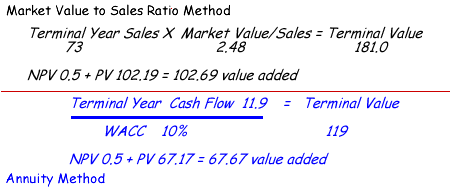|
The Basics
Discounting
Net Present Value
Terminal Value
Value Added
The Decisions
Discount Rate
Hurdle Rate
Weighted Average Cost of Capital
(WACC)
The Math
Estimate Terminal
Value
Annuity Method
Market Value/Sales
Compare Methods
DCF Key Questions
Combine Action Plans
Key Points
|
Compare annuity to market value/sales ratio methods
Before "the boss" set up the Excel formula, she
already knew the two results for the value
added would not be the same. She suspected
market value/sales ratio approach would look better.
- the market value/sales ratio considers investors'
expectations on future sales, forever. Even though
it is an industry average, in her experience sales
estimates are often optimistic.
- The annuity method factors in costs of staying competitive
in a mature market with lots of competition. Eventually, its value
is going to decline.
First calculate the terminal value, then its PV and add
that to the NPV of the growth phases to determine the total value added.
Note that the industry WACC (10.0%) is used in annuity method
and as the discount rate to calculate the
PV
of the Terminal Value in both methods. Earlier
we had calculated the NPV of the growth phase.

"The boss's" first observation: 99% of the value
added using both methods comes from the terminal year - an assumption
of about performance in sixth year and beyond. Her readings indicated the 60
to 80% of the value added in most projects comes from the terminal year, but 99%
makes this project suspicious using either method. She would question the
project's performance the first five years during development, introduction
and growth.
Now, she has enough background to ask
informed questions, has considered the relationships, and has formed
a few opinions.
 Market Value to Sales Method
Market Value to Sales Method |
|
Key Questions

|
|